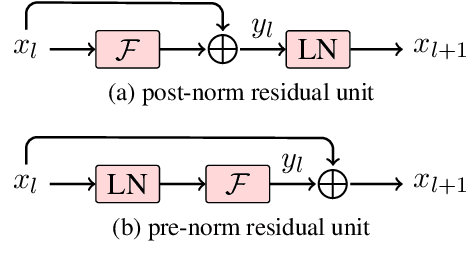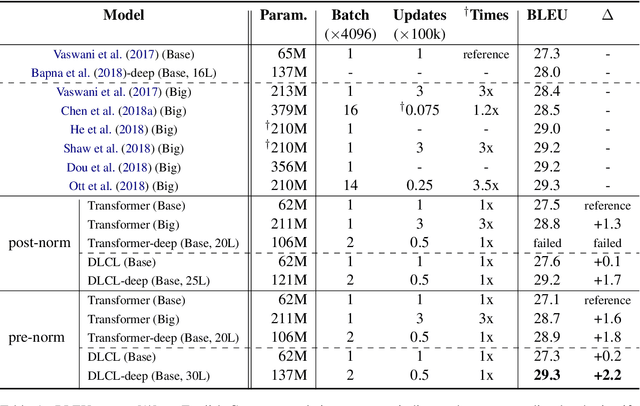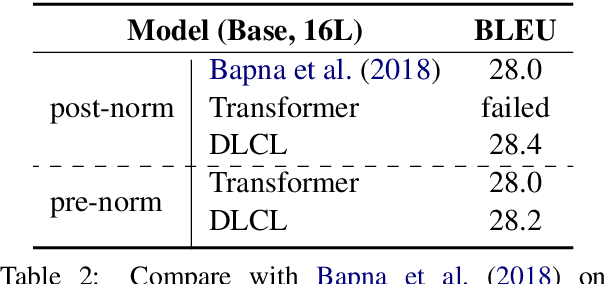Changliang Li
RankNAS: Efficient Neural Architecture Search by Pairwise Ranking
Sep 17, 2021



Abstract:This paper addresses the efficiency challenge of Neural Architecture Search (NAS) by formulating the task as a ranking problem. Previous methods require numerous training examples to estimate the accurate performance of architectures, although the actual goal is to find the distinction between "good" and "bad" candidates. Here we do not resort to performance predictors. Instead, we propose a performance ranking method (RankNAS) via pairwise ranking. It enables efficient architecture search using much fewer training examples. Moreover, we develop an architecture selection method to prune the search space and concentrate on more promising candidates. Extensive experiments on machine translation and language modeling tasks show that RankNAS can design high-performance architectures while being orders of magnitude faster than state-of-the-art NAS systems.
Layer-Wise Multi-View Learning for Neural Machine Translation
Nov 03, 2020



Abstract:Traditional neural machine translation is limited to the topmost encoder layer's context representation and cannot directly perceive the lower encoder layers. Existing solutions usually rely on the adjustment of network architecture, making the calculation more complicated or introducing additional structural restrictions. In this work, we propose layer-wise multi-view learning to solve this problem, circumventing the necessity to change the model structure. We regard each encoder layer's off-the-shelf output, a by-product in layer-by-layer encoding, as the redundant view for the input sentence. In this way, in addition to the topmost encoder layer (referred to as the primary view), we also incorporate an intermediate encoder layer as the auxiliary view. We feed the two views to a partially shared decoder to maintain independent prediction. Consistency regularization based on KL divergence is used to encourage the two views to learn from each other. Extensive experimental results on five translation tasks show that our approach yields stable improvements over multiple strong baselines. As another bonus, our method is agnostic to network architectures and can maintain the same inference speed as the original model.
Learning Architectures from an Extended Search Space for Language Modeling
Jun 05, 2020



Abstract:Neural architecture search (NAS) has advanced significantly in recent years but most NAS systems restrict search to learning architectures of a recurrent or convolutional cell. In this paper, we extend the search space of NAS. In particular, we present a general approach to learn both intra-cell and inter-cell architectures (call it ESS). For a better search result, we design a joint learning method to perform intra-cell and inter-cell NAS simultaneously. We implement our model in a differentiable architecture search system. For recurrent neural language modeling, it outperforms a strong baseline significantly on the PTB and WikiText data, with a new state-of-the-art on PTB. Moreover, the learned architectures show good transferability to other systems. E.g., they improve state-of-the-art systems on the CoNLL and WNUT named entity recognition (NER) tasks and CoNLL chunking task, indicating a promising line of research on large-scale pre-learned architectures.
Does Multi-Encoder Help? A Case Study on Context-Aware Neural Machine Translation
May 17, 2020



Abstract:In encoder-decoder neural models, multiple encoders are in general used to represent the contextual information in addition to the individual sentence. In this paper, we investigate multi-encoder approaches in documentlevel neural machine translation (NMT). Surprisingly, we find that the context encoder does not only encode the surrounding sentences but also behaves as a noise generator. This makes us rethink the real benefits of multi-encoder in context-aware translation - some of the improvements come from robust training. We compare several methods that introduce noise and/or well-tuned dropout setup into the training of these encoders. Experimental results show that noisy training plays an important role in multi-encoder-based NMT, especially when the training data is small. Also, we establish a new state-of-the-art on IWSLT Fr-En task by careful use of noise generation and dropout methods.
Single Channel Speech Enhancement Using Temporal Convolutional Recurrent Neural Networks
Feb 02, 2020



Abstract:In recent decades, neural network based methods have significantly improved the performace of speech enhancement. Most of them estimate time-frequency (T-F) representation of target speech directly or indirectly, then resynthesize waveform using the estimated T-F representation. In this work, we proposed the temporal convolutional recurrent network (TCRN), an end-to-end model that directly map noisy waveform to clean waveform. The TCRN, which is combined convolution and recurrent neural network, is able to efficiently and effectively leverage short-term ang long-term information. Futuremore, we present the architecture that repeatedly downsample and upsample speech during forward propagation. We show that our model is able to improve the performance of model, compared with existing convolutional recurrent networks. Futuremore, We present several key techniques to stabilize the training process. The experimental results show that our model consistently outperforms existing speech enhancement approaches, in terms of speech intelligibility and quality.
Learning Deep Transformer Models for Machine Translation
Jun 05, 2019



Abstract:Transformer is the state-of-the-art model in recent machine translation evaluations. Two strands of research are promising to improve models of this kind: the first uses wide networks (a.k.a. Transformer-Big) and has been the de facto standard for the development of the Transformer system, and the other uses deeper language representation but faces the difficulty arising from learning deep networks. Here, we continue the line of research on the latter. We claim that a truly deep Transformer model can surpass the Transformer-Big counterpart by 1) proper use of layer normalization and 2) a novel way of passing the combination of previous layers to the next. On WMT'16 English- German, NIST OpenMT'12 Chinese-English and larger WMT'18 Chinese-English tasks, our deep system (30/25-layer encoder) outperforms the shallow Transformer-Big/Base baseline (6-layer encoder) by 0.4-2.4 BLEU points. As another bonus, the deep model is 1.6X smaller in size and 3X faster in training than Transformer-Big.
Downhole Track Detection via Multiscale Conditional Generative Adversarial Nets
Apr 17, 2019



Abstract:Frequent mine disasters cause a large number of casualties and property losses. Autonomous driving is a fundamental measure for solving this problem, and track detection is one of the key technologies for computer vision to achieve downhole automatic driving. The track detection result based on the traditional convolutional neural network (CNN) algorithm lacks the detailed and unique description of the object and relies too much on visual postprocessing technology. Therefore, this paper proposes a track detection algorithm based on a multiscale conditional generative adversarial network (CGAN). The generator is decomposed into global and local parts using a multigranularity structure in the generator network. A multiscale shared convolution structure is adopted in the discriminator network to further supervise training the generator. Finally, the Monte Carlo search technique is introduced to search the intermediate state of the generator, and the result is sent to the discriminator for comparison. Compared with the existing work, our model achieved 82.43\% pixel accuracy and an average intersection-over-union (IOU) of 0.6218, and the detection of the track reached 95.01\% accuracy in the downhole roadway scene test set.
Reinforcement Learning Based Emotional Editing Constraint Conversation Generation
Apr 17, 2019



Abstract:In recent years, the generation of conversation content based on deep neural networks has attracted many researchers. However, traditional neural language models tend to generate general replies, lacking logical and emotional factors. This paper proposes a conversation content generation model that combines reinforcement learning with emotional editing constraints to generate more meaningful and customizable emotional replies. The model divides the replies into three clauses based on pre-generated keywords and uses the emotional editor to further optimize the final reply. The model combines multi-task learning with multiple indicator rewards to comprehensively optimize the quality of replies. Experiments shows that our model can not only improve the fluency of the replies, but also significantly enhance the logical relevance and emotional relevance of the replies.
 Add to Chrome
Add to Chrome Add to Firefox
Add to Firefox Add to Edge
Add to Edge